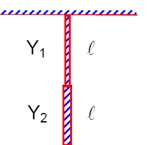Physics Mechanical Properties of Solids
Get insights from 60 questions on Physics Mechanical Properties of Solids, answered by students, alumni, and experts. You may also ask and answer any question you like about Physics Mechanical Properties of Solids
Follow Ask QuestionQuestions
Discussions
Active Users
Followers
New answer posted
2 months agoContributor-Level 10
Surface energy of bubble charge in surface area surface tension
New answer posted
2 months agoContributor-Level 9
For Wire-A
F / (πr_A²) = Y (l_A / 2) . (1)
For Wire-B
F / (πr_B²) = Y (l_B / 4) . (2)
From equations (1) and (2), we can write
(l_A / (2r_A²) = (l_B / (4r_B²) ⇒ l_B/l_A = 2 (r_B/r_A)² ⇒ x = l_B = 32
New answer posted
2 months agoContributor-Level 10
The bulk modulus B is calculated as:
B = -ΔP / (ΔV/V) = (ρgh) / (ΔV/V) = (10³ * 9.8 * 2 * 10³) / (1.36 * 10? ²) = 1.44 * 10? N/m²
New answer posted
2 months agoContributor-Level 10
As it just floats B = mg
(4πR³/3) (ρ? ) (g) = (4πR³/3 - 4πr³/3) (ρ? ) (g)
R³ = (R³ - r³) (27/8)
On solving we get,
r = 8/9 R (approx)
New answer posted
2 months agoContributor-Level 10
B (ΔV/V) = ΔP
ΔV/V = ΔP/B = (4 x 10? )/ (8 x 10¹? ) = 1/20
V = l³
dV = 3l² dl
dV/V = 3l²dl/l³ = 3dl/l
ΔV/V = 3 (Δl/l); 1/20 = 3 (Δl/l); ΔV/V = 1/60
% (Δl/l) = 100/60 = 1.67%
New answer posted
3 months agoContributor-Level 10
Loss in elastic potential energy = Gain in KE
½ (YA/L)x² = ½mv²
0.5 * (0.5*10? * 10? / 0.1) * (0.04)² = 20*10? ³ v²
0.5 * (5*10²) * 1.6*10? ³ = 20*10? ³ v²
0.4 = 20*10? ³ v²
v² = 20 => v = √20 ≈ 4.47 m/s
(Re-checking calculations)
0.5 * ( (0.5e9 * 1e-6) / 0.1) * (0.04)^2 = 0.5 * (5e2) * 1.6e-3 = 4.
0.5 * 20e-3 * v^2 = 10e-3 v^2
4 = 10e-3 v^2
v^2 = 400 => v = 20 m/s
New answer posted
3 months agoContributor-Level 9
Y? = (F/A) / (Δl? /l)
Y? = (F/A) / (Δl? /l)
Y = (F/A) / (Δl? + Δl? )/ (2l)
= (F/A) / ( (1/2) * (Δl? /l + Δl? /l) )
= (F/A) / ( (1/2) * (F/ (AY? ) + F/ (AY? ) )
= 2Y? Y? / (Y? + Y? )
Taking an Exam? Selecting a College?
Get authentic answers from experts, students and alumni that you won't find anywhere else
Sign Up on ShikshaOn Shiksha, get access to
- 65k Colleges
- 1.2k Exams
- 679k Reviews
- 1800k Answers

